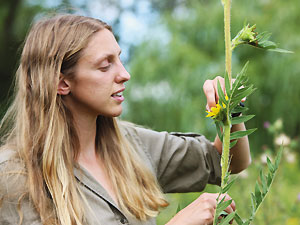The Nature Conservancy has acquired a new tract to the south of their existing 592 acre preserve at Weaver Dunes. The new tract is 175 acres, and includes over 4000 feet of shoreline on Weaver Bottoms. Once the 100 acres of crop field are restored to prairie, it will provide direct access for Weaver Bottoms turtles to sand prairie for turtle nesting.
That restoration effort will use only locally collected seed. This is where we could use your help. Only a few species of the needed seed can be mechanically collected. We rely on hand collection for most species. We have scheduled several seed collection sessions, where we provide the knowledge and equipment needed to do this work. What we are looking for are volunteers who can spend a few hours walking the sand prairie with other folks, picking seed observing the plants and animals, and chatting with the other folks. It is light work. But we really could use more hands.
Seed collection sessions are scheduled from 10am to 1:30pm on:
- Saturday, September 19
- Sunday, October 4
- Saturday, October 24
Meet at the maintenance building area, down the driveway from the sign on Wabasha Co. 84. For more information on the work days, contact me.
I am also willing to drive over and lead groups to collect seed, if the number of person-hours would be significant. I feel this could be an opportunity for students to see, feel, smell, and really experience a large native prairie. And Weaver Dunes has excellent fall color.
In a few years, we hope this ‘ghost population’ of turtles in Weaver Bottoms will once again start reproducing. You can help. Let me know if you can help, or if you know of any leads on groups that could help with seed collection.
Joel Dunnette
507-365-8091 (h)
507-269-7064 (cell)



 Posted by sj
Posted by sj 
 Victoria Ranua, a MnNPS member and Environmental Assessment Specialist at Shakopee Mdewakanton Sioux Community is currently profiled on the
Victoria Ranua, a MnNPS member and Environmental Assessment Specialist at Shakopee Mdewakanton Sioux Community is currently profiled on the 





